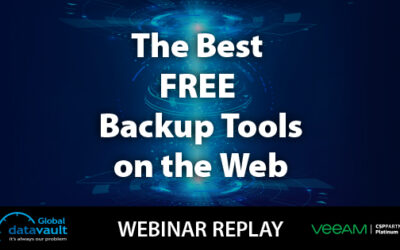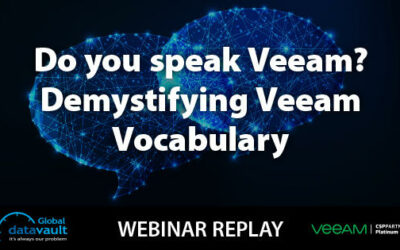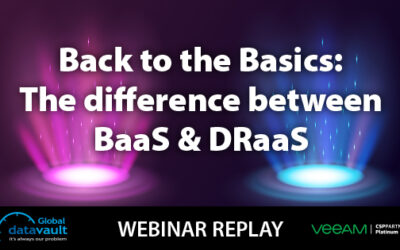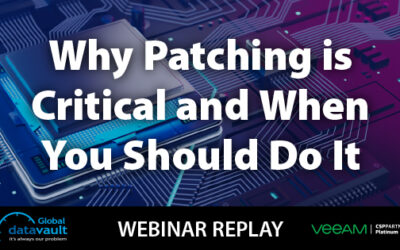Do you have questions about Veeam VMCE Certification? We have answers! Our recent webinar focused on the importance of Veeam VMCE certification.
Steven New, Senior Support Manager, and Kelly Culwell our Product Manager discuss key points including what the VMCE program is, who should get certified, and how VMCE certification benefits organizations in some unexpected ways. You’ll find summaries of each main point in the transcript below with time stamps to help you find that specific part of the discussion during the webinar.
- What is the VMCE? 02:45
- What are the requirements for sitting for the VMCE exam? 05:00
- If I am current with my certification, do I have to take the class again? 06:01
- What are your recommendations for technical background or experience? 07:52
- What can you tell us about the Veeam VMCE Certification exam? : 22:33

What is the Veeam VMCE Certification program? 02:45
Kelly: The VMCE is the Veeam® Certified Engineer certification. It is an industry-standard certification that proves your merit with the product(s). Cisco has it, VMware has it, pretty much anybody you can think about has their own industry certification. This validates that you know what you’re doing, and it deals with the Veeam Availability Suite, which is Veeam Backup & Replication™ and Veeam One™, generally, people who deal with Veeam, or any product, long enough basically know how to administer it, how to deal with Veeam specifically. It goes beyond just knowing about backup jobs and deals with the complete backup needs with disaster recovery, anything that encapsulates the whole backup situation and talks about deep understanding of data protection and future needs.

What are the requirements for sitting for the VMCE exam? 05:00
Steven: The current requirements are to attend the three-day Veeam Availability Suite Configuration and Management training course. Once you attend the three-day class, you can log on to the Veeam VMCE training portal, and then after your class has been verified, then you will be able to schedule the VMCE test on the Pearson VUE website.
If I am current with my certification, do I have to take the class again? 06:01
Steven: The current test that’s out right now is the VMCE 2021 test that was just released in June. The test prior to that is the VMCE 2020. What that means is if you are currently certified to VMCE 2020, then you can skip the three-day training course and go straight to the VMCE 2021 exam.
What are your recommendations for technical background or experience? 07:52
Steven: From a technical standpoint, I would recommend that you have deep understanding of the actual hypervisor, how [Hyper-V] checkpoints and or [VMware] snapshots work inside a hypervisor, because that’s actually what Veeam does. It issues an API call to the hypervisors that triggers a checkpoint or a snapshot. Also, I would recommend that you understand networking basic concepts, TCP/IP you’re going to need, and you’re going to need knowledge of different storage and so forth regarding the just basic requirements to sit for the exam.

What can you tell us about the VMCE exam? 22:33
Steven: The first thing that I can tell you is that it’s not an easy test. It is an industry-standard test that is comparable to most industry-standard certifications. You’re not going to be able to go in there without reading the documentation and pass the test. You can take the test multiple times if needed. They have recently increased the amount of time that you can take the test, which also tells you how difficult it is.
It is a proctored test through Pearson VUE. It is seventy-five minutes and 50 multiple choice or multiple response item questions. And what I mean by that is they will give you a question and then they will say, select the best two out of three, or they will give you a scenario-based question where it’ll give you an example of Sue has 400 VMs, what’s the best copy job that will provide her with an RTO and RPO of four hours, stuff like that. There are several different versions, so if you do fail the exam, if you go back and take it, you will not get the same exam twice.
More Cybersecurity Webinars
Webinar: Best Free Backup Tools
In this episode of Global Data Vault's "Back to Basics" webinar series, we look at the best free backup tools on the web. It’s a bit of a show and tell, as Steven New, Global Data Vault’s Senior Support Manager, demonstrates how each of them can be used for planning...
Webinar: Understanding Veeam? Demystifying Veeam Vocabulary
Webinar: Understanding Veeam? Demystifying Veeam VocabularyIn this episode of our Back to Basics Veeam webinar series, we provide you with a deeper understanding of some of the more common Veeam vocabulary. Many of the terms used in Veeam are multipurpose, so here we...
Webinar: The Difference Between BaaS and DRaaS
Global Data Vault is kicking off a new webinar series that takes us Back to the Basics. For our inaugural episode, we are breaking down the difference between Backup as a Service (BaaS) and Disaster Recovery as a Service (DRaaS), with a little bit of Veeam and Global...
Cybersecurity Webinar: Why Patching is Critical
The topic of the June 2021 Global Data Vault webinar was patching: why it's so critical and when it should be done, and best practices for how often you should do it. Topics covered include what to patch, why patching is so essential, how often it should be done, how...




0 Comments